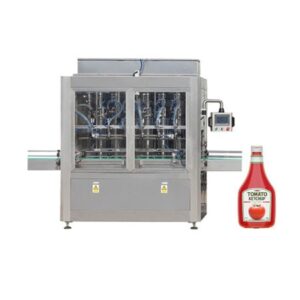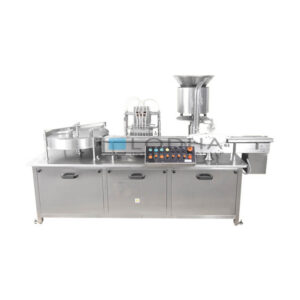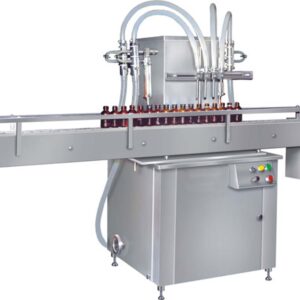Description
| Parameter | Description |
|---|---|
| Filling Machine Type | (e.g., Rotary, Linear, Piston, Gravity) |
| Capacity | (e.g., bottles per minute, liters per hour) |
| Bottle Size Range | (e.g., minimum and maximum bottle dimensions) |
| Filling Accuracy | (e.g., percentage or tolerance) |
| Filling Volume Range | (e.g., minimum and maximum filling volumes) |
| Capping Machine Type | (e.g., Screw capper, Snap capper) |
| Capping Speed | (e.g., caps per minute) |
| Cap Size Range | (e.g., minimum and maximum cap dimensions) |
| Labeling Machine Type | (e.g., Wrap-around, Front and back, Top) |
| Labeling Speed | (e.g., labels per minute) |
| Label Size Range | (e.g., minimum and maximum label dimensions) |
| Conveyor System | (e.g., type of conveyor, material, length) |
| Material Handling | (e.g., orientation, accumulation, rejection systems) |
| Control System | (e.g., PLC, HMI, SCADA) |
| Power Supply | (e.g., voltage, phase, frequency) |
| Air Supply | (e.g., pressure, quality) |
| Utilities | (e.g., water, steam, gas requirements) |
| Safety Features | (e.g., guarding, emergency stop, interlocks) |
Introduction to Filling Lines
In the industrial sector, a filling line plays a very important role in the process of manufacturing. They are used extensively in food and beverage, pharmaceuticals, cosmetics, and chemicals industries for the production of various substances in containers.
A typical filling line is an integrated assembly that has numerous machines performing different operations in automating the filling procedure. Others, so include container cleaning equipment, liquid fillers, capping machines, labelers, and packagers.
Any filling line worth its name aims at improving accuracy; uniformity as well as swiftness when it comes to the occupation of vessels with its content without wastage or interference by manpower. Advanced technologies have been incorporated into modern filling lines like sensors, robots, and programmable logic controllers which helps them achieve product quality besides optimizing efficiency.
For any manufacturer who wants to hit their production target while cutting down costs and observing regulations in place for compliance then running a competent filling line is not optional. Designing and configuring a filing line takes into account elements such as the size of the container being used, the viscosity of the product being filled in it, and the units required to be produced.
Types of Filling Lines
1. Gravity-Fed Filling Lines
Gravity-fed lines rely on gravitational pull to move liquids into containers positioned below nozzles through which the fluids flow under their weight. Such lines are ideal for handling liquids with low viscosities like water, juice, and oils. It is quite simple in design and thus suitable for use at average-speed production levels.
2. Pressure Fillers
Pressure-filling lines make use of pressure to push fluids into containers. These lines usually have a pressurized reservoir that supplies fluid to the filling nozzles. As the containers are filled, pressure is maintained to ensure uniform levels of filling. Pressure feeder systems find application in the filling of carbonated drinks, sauces, and other substances that flow at controlled rates.
3. Piston Filling Lines
Piston-feeding mechanisms are employed in piston-feeding lines for accurate delivery of predetermined quantities of liquid in containers. This line is highly flexible and can handle many different viscosities ranging from watery liquids to pastes with high viscosity. The pharmaceuticals, cosmetics, and food processing industries use piston-filling lines most commonly since they need absolute precision in their operations.
4. Vacuum Filling Lines
It operates by creating a vacuum inside the container which causes liquid to enter it through suction. When filled, the vacuum is broken thus sealing off the container and securing it tightly instead of allowing air into it thereby making it free from external influences such as dust pollution and insect attacks; preventing evaporation or oxidation (EPA 2019). Vacuum fillers are better suited for handling foaming products or products requiring exact fill levels; hence it has gained great favor among pharmaceutical and chemical companies.
5. Net Weigh Filling Lines
Net weight filling apparatus consists of scales used to measure out specific weight contents required for each package bought into them before being discharged into given packages and cartons respectively using various dispensing units based on whether they are dry powders granules or other kinds of solids which must be put into bags or boxes accurately despite their small size (Kleeman & Twardowski 1997). For this cause, net-weigh feeders can also incorporate bagging machines or case packers to construct automated packaging plants.
6. Overflow Filling Lines
Overflow fillers perform the task of filling containers to a consistent level by permitting excess liquid to flow over the top. Containers are placed under a fill head, and as the product is added to each container, it begins to overflow into a catch basin ensuring that all containers have the same fill levels. Overflow fillers are typically used for products from the detergent, cleaning solution, and chemical industries.
Applications of Filling Line
1. Food and Beverage Industry
Filling lines have found extensive applications in the food and beverage industry in packaging various products like juices, soft drinks, sauces, condiments, oils, and dairy. These lines ensure precision bottle can pouch or jar filling while preserving product quality and extending shelf life. Whether it is a high-speed carbonated machine or an exactitude sauce-filling line, filling lines are vital as far as producing packed foodstuff and beverages is concerned.
2. Pharmaceutical Industry
In the pharmaceutical industry, filling lines are employed for accurately dosing and packaging medications, syrups, creams, and other pharmaceutical products (Pareto et al 2011). Such machines must be capable of meeting stringent regulatory criteria such as precise product volumes at desired temperatures so that both safety of use, as well as effectiveness, can be maintained throughout their shelf life span; they will be useful either when packing vials with chemo-reactive medicines or squeezing them into blister packs since these factors determine how well they preserve their viability (Grossman & Springer 1999).
3. Cosmetics and Personal Care Products
Cosmetics formulations require accurate filling to maintain evenness across consumers’ choices. Packaging in this sector involves lotions/creams/shampoos containing perfumes/makeup etc., which fit perfectly into bottles/jars/tubes/aerosol cans respectively while ensuring correct weights plus nice looking appearances on shelves that advertise brands thus attracting customers (Struzik 1994).
4. Chemical Industrial Products
Chemical and industrial products are typically sold in bulk and therefore need efficient packaging solutions to enable storage, transportation, and distribution. Filling lines in the sector are used for packaging for example detergents, cleaning agents, lubricants, adhesives, or automotive fluids. These lines must have the ability to handle a wide range of viscosities as well as container sizes; however, they must also adhere to safety procedures that prevent spillages or contamination.
5. Household Products
From household cleaners to pet care products; there is an array of household items that can be packaged using filling lines. These filling lines help in accurate bottle filling with several products such as disinfectants, air fresheners laundry detergents, and pet shampoos. Typically equipped with features like anti-drip nozzles, capping systems, and labeling equipment, filling lines in this category ease the packaging process while improving product presentation.
6. Agricultural and Horticultural Products
In the agricultural and horticultural sectors, filling lines are used to package fertilizers, pesticides herbicides among other agricultural chemicals. Such lines ensure that products are dosed with accuracy while reducing wastage as well as environmental pollution associated with misdirecting any content beyond the intended target area. Filling machines built specifically for the industry could accommodate different forms of packaging including bottles jugs drums or even bulk containers for use by various stakeholders such as farmers landscapers or agricultural experts.
Functionalities of Filling Line
1. Container Handling
Container handling is one of the main functions performed by a filling line where bottles cans jars pouches etc., are handled at the start of the production process since they will be filled later on. Container handling in any filling system may comprise mechanisms for sorting and orienting transporting containers to the fill station thereby ensuring continuous flow throughout packaging processes.
2. Cleaning and Sterilization
In industries such as food pharmaceuticals cosmetics among others where clean sterile containers are paramount to ensure product integrity and safety, filling lines feature cleaning and sterilization equipment such as rinsing machines autoclaves, etc., for removing contaminants from containers before filling. This guarantees that no contamination happens and that regulatory standards are adhered to.
3. Filling
The core purpose of a filling line is, obviously, the filling of containers with products. Different types of filling machines include gravity fillers piston fillers vacuum fillers or net weigh fillers depending on different products and production requirements. These machines precisely dispense the appropriate volume into the respective container thereby ensuring constant levels of fills and minimal waste of product.
4. Capping and Sealing
Containers that have been filled need to be sealed to prevent leakage tampering or contamination. The capping and sealing devices on the lining do this job by fitting caps, lids, or seals onto bottles exactly where they should be. In some cases, screw capping snap capping or induction sealing techniques may be used by capping/sealing machinery based on container shape or closure type.
5. Labeling and Coding
After being filled but before being sealed, it is common for containers to go through labeling as well as coding once they leave the production line to provide important information to buyers along with other stakeholders like the FDA. Labeling equipment present on the filing line puts labels showing product specifications brand name bar codes expiry dates among others before reaching consumers themselves who can read them off labels placed over their packaging material during sales without any problem. Batch numbers manufacturing dates traceability information among other things will find their way on all these surfaces through inkjet printers and laser markers whether using coded messages that shall remain invisible until exposed under certain conditions such as ultra-violet radiation reveal everything imprinted invisibly encoded data.
6. Inspection & Quality Control
As an item is being filled, monitoring its quality and identifying any faults or inconsistencies in it is necessary. For this task inspection systems integrated into the filling line inspect containers for leaks, fill level accuracy, label placement, and overall product quality. To control their quality, often automated vision systems, sensors, and weighing mechanisms are used guaranteeing that only compliant products make it to the markets.
7. Packaging and Palletizing
Once containers are filled up, sealed off, labeled as well, and checked on they can then be packed and ready for distribution. Case packers, cartoners shrink wrappers and palletizers may be packaging equipment found on the filling line which automates the grouping wrapping, and stacking of containers onto pallets before shipment is done. These systems optimize efficiency while minimizing labor costs linked with manual handling.
8. Integration and Automation
Integration and automation of processes is a key feature in modern-day filling lines. Filling lines are often integrated with other production equipment such as conveyors; robots; material handling systems e.t.c to come up with fully automated packaging solutions. Apart from controlling and overseeing the entire filling line through programmable logic controllers (PLCs) and human-machine interfaces (HMIs), their main aim is optimizing efficiency by reducing downtime.
Frequently Asked Questions
1. What is a filling line?
A series of interconnected machines used in manufacturing to automatically fill containers with liquids, powders, or granules.
2. What types of products can be filled using a filling line?
Beverages, food items, pharmaceuticals, cosmetics, chemicals, and household products are some examples of what can pass through filling lines.
3. How does a filling line work?
An empty container is passed through several stations that clean it fill it with the product then seal it label it inspect it and pack it for distribution.
4. What types of filling machines are commonly used in filling lines?
These can be gravity fillers piston fillers vacuum fillers net weigh fillers pressure fillers to overflow fillers etc each one having its suitability depending on the type of product being handled as well as production needs
5. What are the benefits of using a filling line?
The use of a filling line has advantages such as increased efficiency of production, consistent fill levels, reduced labor costs, better product quality, and an improved packaging presentation.
6. How can I determine the right type of filling line for my product?
When choosing a filling line, there are several things you should consider. These factors include product viscosity, container size, production volume, and desired fill accuracy.
7. Are filling lines customizable to accommodate different products and containers?
Certainly yes! There is a possibility of customizing filling lines with various characteristics and modifications that will make it possible to handle different kinds of products as well as the sizes of containers that they come in.
8. What maintenance is required for a filling line?
Regular maintenance is necessary to ensure the smooth running and long life of a filling line and involves cleaning its parts; lubricating them; and inspecting those parts among other steps.
9. Can filling lines be integrated with other packaging equipment?
Filling lines can also be connected to capping machines or labeling machines, inspection systems, or any other kind of packaging equipment thereby making them automated packaging solutions.
10. How can I optimize the performance of my filling line?
Optimization could mean many things when it comes to how best you can improve your filling machine’s output by selecting the right machinery in terms of – operator training – preventive maintenance – process optimization – key performance indicators.





